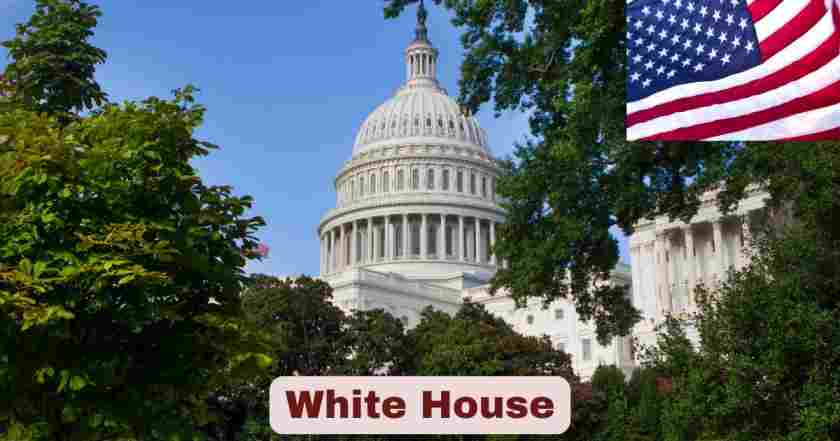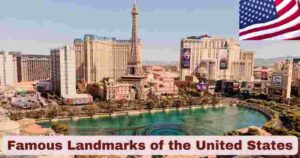The White House stands as the most iconic symbol of American democracy and presidential power in 2025. As the official residence and workplace of the President of the United States, this historic building continues to serve as the epicenter of American political life, hosting crucial meetings, diplomatic events, and policy announcements that shape the nation’s future.
1. White House in the US
The White House serves as the primary residence and executive office of the President of the United States, representing the heart of American democratic governance. Located in Washington, D.C., this neoclassical mansion has been the home of every U.S. president since John Adams in 1800, making it one of the most significant political buildings in American history.
| Aspect | Details |
|---|---|
| Official Name | The White House |
| Function | Presidential Residence & Executive Office |
| Established | 1792 (Construction began) |
| First Resident | John Adams (1800) |
| Architectural Style | Neoclassical |
| Total Rooms | 132 |
The White House administration operates as a complex governmental machine, coordinating national and international affairs from this historic location. The building’s significance extends beyond its role as a residence, serving as a symbol of American democracy and the executive branch’s power. Modern White House leadership continues to utilize this space for critical decision-making processes that affect millions of Americans and global citizens alike.
The building’s White House location provides strategic advantages for governmental operations, positioned centrally in the nation’s capital to facilitate communication with Congress, federal agencies, and diplomatic missions. White House policies are developed and refined within these walls, making it the nerve center of American domestic and foreign policy initiatives.
2. White House Address
The official White House address is 1600 Pennsylvania Avenue NW, Washington, D.C. 20500, representing one of the most recognizable addresses in the world. This prestigious location places the presidential residence at the heart of the nation’s capital, strategically positioned between the Capitol Building and the Washington Monument.
| Address Component | Information |
|---|---|
| Street Number | 1600 |
| Street Name | Pennsylvania Avenue NW |
| City | Washington |
| District | District of Columbia (D.C.) |
| ZIP Code | 20500 |
| Coordinates | 38.8977° N, 77.0365° W |
Pennsylvania Avenue serves as America’s Main Street, connecting the White House to the U.S. Capitol Building, symbolizing the relationship between the executive and legislative branches of government. The White House location was specifically chosen by President George Washington and city planner Pierre L’Enfant to maximize the building’s symbolic and practical importance within the federal city’s layout.
White House security considerations have evolved significantly over the decades, with the address becoming synonymous with the highest levels of protection and surveillance. The White House construction originally designed by James Hoban has been modified repeatedly to accommodate modern security requirements while preserving its historical integrity and architectural significance.
3. White House Live Coverage and Media Access
White House live coverage provides Americans and global audiences with real-time access to presidential activities, press conferences, and major announcements. Modern technology enables continuous streaming of official events, allowing unprecedented transparency in presidential communications and governmental operations.
| Media Platform | Coverage Type |
|---|---|
| Official Website | Live Streams |
| C-SPAN | Press Briefings |
| Major Networks | Breaking News |
| Social Media | Real-time Updates |
| Press Pool | Event Coverage |
| Digital Platforms | 24/7 Access |
The White House newsroom coordinates media access and ensures proper distribution of presidential messages through various channels. White House press corps members receive accreditation to cover events, maintaining professional journalism standards while providing public access to governmental proceedings. Live coverage includes presidential speeches, White House briefings, cabinet meetings, and diplomatic events.
White House photographer positions capture historical moments and provide visual documentation of presidential activities for archival purposes and public consumption. The White House press maintains rigorous standards for accuracy and timeliness in reporting presidential activities and policy announcements to the American public.
4. White House News and Information Distribution
White House news serves as the official source for presidential announcements, policy changes, and governmental updates. The communications team works continuously to ensure accurate and timely distribution of information to media outlets, government agencies, and the general public.
| News Category | Distribution Method |
|---|---|
| Policy Announcements | Press Releases |
| Emergency Updates | Alert Systems |
| Diplomatic News | International Channels |
| Domestic Affairs | National Media |
| Executive Orders | Official Publications |
| Presidential Travel | Media Pool Coverage |
White House statements carry significant weight in shaping public opinion and policy direction. The White House response to national and international events often sets the tone for governmental action and public discourse. White House proclamations serve as formal declarations on matters of national importance, ceremonial occasions, and policy initiatives.
White House updates provide regular communication about presidential activities, upcoming events, and administrative priorities. The White House report system ensures comprehensive documentation of governmental activities for historical record-keeping and public accountability purposes.
5. White House Press Secretary Operations
The White House Press Secretary serves as the primary spokesperson for the President, conducting daily briefings and serving as the main conduit for information between the administration and the media. This crucial role requires exceptional communication skills, policy knowledge, and the ability to represent presidential positions accurately under intense scrutiny.
| Press Secretary Duties | Frequency |
|---|---|
| Daily Press Briefings | Weekdays |
| Media Interviews | As Needed |
| Statement Preparation | Daily |
| Crisis Communication | Immediate |
| Policy Explanation | Ongoing |
| International Media | Regular |
The White House briefing room serves as the primary venue for these interactions, equipped with modern communication technology and seating for accredited journalists. White House briefings cover domestic policy, foreign affairs, presidential schedules, and responses to current events affecting the nation.
Press Secretary responsibilities include coordinating with various White House departments to ensure accurate information dissemination and maintaining productive relationships with White House correspondents who cover the administration regularly. The briefing process requires extensive preparation and coordination with senior staff to address complex policy questions and emerging issues.
6. White House Public Events and Ceremonies
White House public events showcase the ceremonial aspects of presidential leadership while maintaining the dignity and traditions associated with America’s highest office. These carefully orchestrated gatherings serve multiple purposes, from diplomatic relations to public engagement and historical commemoration.
| Event Categories | Purpose |
|---|---|
| State Ceremonies | Diplomatic protocol |
| Award Presentations | Recognition events |
| Holiday Celebrations | Traditional observances |
| Policy Announcements | Public engagement |
| Cultural Programs | Arts and heritage |
| Memorial Services | National remembrance |
Ceremonial functions demonstrate the presidency’s role as both head of government and head of state, balancing political leadership with symbolic representation of American values and traditions. Public engagement through these events maintains the connection between the presidency and the American people.
Event coordination requires extensive planning between multiple departments to ensure appropriate protocol, security measures, and meaningful public participation. White House ceremonies often set precedents and create lasting memories that contribute to the building’s historical significance and cultural importance.
7. White House Architecture and Design
White House architecture represents a masterpiece of neoclassical design, combining functionality with symbolic grandeur appropriate for the leader of the world’s oldest modern democracy. The building’s architectural elements reflect both American democratic ideals and practical requirements for executive governance.
| Architectural Feature | Description |
|---|---|
| Style | Neoclassical |
| Primary Material | Sandstone (painted white) |
| Floors | 6 levels |
| Total Square Footage | 55,000 sq ft |
| Porticos | North and South |
| Columns | Ionic order |
James Hoban’s original design established the architectural framework that continues to define the building’s appearance and functionality. White House construction has undergone numerous renovations and expansions to accommodate evolving presidential needs while preserving historical authenticity and architectural integrity.
The building’s design incorporates both public and private spaces, balancing the need for ceremonial grandeur with comfortable residential living. Architectural significance extends beyond aesthetics to encompass symbolic representation of American democratic values and presidential authority in the global community.
8. White House Briefing Room and Media Operations
The White House briefing room serves as the epicenter of presidential communications, hosting daily press briefings and serving as the primary interface between the administration and the news media. This specially designed space accommodates the complex technical requirements of modern journalism while maintaining the dignity appropriate for presidential communications.
| Briefing Room Features | Specifications |
|---|---|
| Seating Capacity | 49 seats |
| Media Technology | HD cameras, audio systems |
| Broadcast Capabilities | Live streaming |
| Press Corps Access | Assigned seating |
| Security Features | Controlled access |
| Historical Significance | Since 1970 |
Daily briefings provide structured opportunities for journalists to question administration officials about policy decisions, current events, and presidential activities. The briefing format follows established protocols that balance media access with efficient information dissemination and respect for executive branch operations.
Technical infrastructure supports live broadcasting and digital distribution of briefing content to global audiences. Media coordination ensures proper access for White House correspondents while maintaining security protocols and operational efficiency throughout the complex communication process.
9. White House Correspondents and Media Relations
White House correspondents represent major news organizations and serve as the primary link between the presidency and public information dissemination. These journalists maintain permanent access to White House grounds and participate in the daily coverage of presidential activities and governmental operations.
| Correspondent Categories | Access Level |
|---|---|
| Major Networks | Full access |
| Print Media | Regular access |
| Digital Platforms | Growing presence |
| International Press | Selected access |
| Specialty Publications | Limited access |
| Freelance Journalists | Restricted access |
Professional relationships between correspondents and White House staff require mutual respect, accuracy in reporting, and adherence to established protocols for information gathering and dissemination. The press pool system ensures comprehensive coverage of presidential travel and events while managing space and security constraints.
Correspondent responsibilities include accurate reporting, fact-checking, and maintaining professional standards that serve the public interest. White House media relations teams work to facilitate access while protecting sensitive information and maintaining operational security requirements.
10. White House History and Historical Significance
White House history spans over two centuries of American presidential leadership, serving as witness to pivotal moments in national and world history. Every president except George Washington has called this building home, creating layers of historical significance that continue to influence American governance and global diplomacy.
| Historical Periods | Significant Events |
|---|---|
| Early Republic (1800-1829) | Establishment of traditions |
| Civil War Era (1861-1865) | National crisis management |
| Progressive Era (1901-1921) | Modern presidency emergence |
| World Wars (1917-1945) | Global leadership role |
| Cold War (1945-1991) | Superpower diplomacy |
| Modern Era (1991-present) | Global interconnectedness |
Historical preservation efforts ensure that future generations can appreciate the building’s role in American democracy while adapting to contemporary presidential needs. The White House historical significance extends beyond national boundaries to encompass global diplomatic history and international relations development.
Presidential legacies are embedded within the building’s rooms, furnishings, and operational spaces, creating a living museum of American executive leadership. Historical documentation maintains detailed records of presidential activities, decisions, and events that shaped the nation’s trajectory and global influence.
11. White House Press Operations and Communications
White House press operations coordinate comprehensive communication strategies that inform the American public about presidential activities, policy initiatives, and governmental responses to national and international events. This complex system ensures accurate and timely information distribution through multiple channels and platforms.
| Press Operations | Function |
|---|---|
| Daily Briefings | Routine information |
| Press Releases | Official announcements |
| Background Briefings | Policy explanations |
| Exclusive Interviews | Detailed discussions |
| Photo Opportunities | Visual documentation |
| Travel Pool Coverage | Presidential movements |
Communication strategies adapt to evolving media landscapes while maintaining traditional standards for accuracy, accessibility, and public service. The White House press team coordinates with various governmental departments to ensure comprehensive and consistent messaging across all administrative activities and policy initiatives.
Digital transformation has revolutionized press operations, enabling direct communication with citizens through social media, official websites, and streaming platforms while maintaining traditional relationships with established news organizations and professional journalists.
12. White House Press Releases and Official Communications
White House press releases serve as the primary vehicle for official announcements, policy explanations, and presidential statements on matters of national and international importance. These carefully crafted documents maintain consistent messaging and provide authoritative information for media outlets and the general public.
| Press Release Types | Purpose |
|---|---|
| Policy Announcements | New initiatives |
| Executive Orders | Legal directives |
| Diplomatic Statements | International relations |
| Emergency Communications | Crisis response |
| Ceremonial Announcements | Official events |
| Personnel Changes | Staff updates |
Official communication standards ensure accuracy, clarity, and appropriate tone for presidential messages. The White House statement process involves multiple levels of review and coordination to maintain consistency with broader administrative priorities and long-term strategic objectives.
Distribution networks ensure wide dissemination of official communications through traditional media, digital platforms, and direct citizen access channels. Press release coordination involves collaboration between communication staff, policy experts, and senior advisors to ensure comprehensive and accurate information presentation.
13. White House Residence and Living Quarters
The White House residence combines the functional requirements of a family home with the ceremonial needs of the presidency, creating a unique living environment that serves both personal and official purposes. The private quarters provide presidential families with comfortable living spaces while maintaining the dignity appropriate for America’s First Family.
| Residence Features | Description |
|---|---|
| Private Floors | 2nd and 3rd floors |
| Bedrooms | Multiple guest and family rooms |
| Kitchen Facilities | Private family kitchen |
| Recreation Areas | Movie theater, gym, pool |
| Private Office Space | Study areas |
| Guest Accommodations | State guest rooms |
Family living arrangements must balance privacy needs with security requirements and official obligations. The residential spaces undergo periodic renovations to accommodate different presidential families’ preferences while preserving historical integrity and maintaining appropriate standards for America’s most important residence.
White House staff responsible for residence operations ensure smooth daily functioning of household activities, meal preparation, maintenance, and guest services. Residence management requires coordination between family preferences, security protocols, and official entertainment responsibilities.
14. White House Staff and Administrative Operations
White House staff comprises hundreds of dedicated professionals who support presidential operations, policy development, and administrative functions necessary for effective executive branch leadership. This diverse team includes policy advisors, communications specialists, security personnel, and support staff who collectively enable presidential effectiveness.
| Staff Categories | Functions |
|---|---|
| Senior Advisors | Policy development |
| Communications Team | Media relations |
| Security Personnel | Protection services |
| Administrative Staff | Daily operations |
| Policy Specialists | Issue expertise |
| Support Services | Facilities management |
Staff coordination ensures efficient operation of complex presidential schedules, policy initiatives, and governmental functions. The White House staff structure adapts to each administration’s priorities while maintaining institutional knowledge and operational continuity essential for effective governance.
Professional development and training programs ensure staff members maintain the highest standards of public service while developing expertise necessary for effective support of presidential objectives. Staff management balances individual talents with collective organizational goals and public service responsibilities.
15. White House Diplomatic Meetings and International Relations
White House diplomatic meetings with foreign dignitaries, domestic leaders, and distinguished guests represent crucial opportunities for diplomacy, policy coordination, and relationship building that advance American interests and global cooperation. These carefully orchestrated events combine ceremonial elements with substantive discussions that shape international relations.
| Visit Types | Characteristics |
|---|---|
| State Visits | Full diplomatic protocol |
| Official Visits | Formal government meetings |
| Working Visits | Policy-focused discussions |
| Bilateral Meetings | Two-nation focus |
| Multilateral Summits | Multiple participants |
| Ceremonial Events | Honor and recognition |
Diplomatic protocol ensures appropriate respect for visiting dignitaries while maintaining American sovereignty and presidential dignity. White House events require extensive planning, security coordination, and cultural sensitivity to achieve successful outcomes that strengthen international relationships.
Event management involves multiple governmental departments and agencies working together to create memorable experiences that advance American diplomatic objectives. Visit outcomes often include joint statements, agreements, and commitments that shape bilateral and multilateral relationships for years to come.
16. White House Administration and Executive Operations
The White House administration operates as the executive headquarters of the federal government, coordinating policy implementation, regulatory oversight, and intergovernmental relations that affect every aspect of American life. This complex organization manages both domestic and international responsibilities while maintaining democratic accountability and constitutional governance.
| Administrative Functions | Scope |
|---|---|
| Policy Coordination | All federal agencies |
| Budget Management | Entire federal government |
| Legislative Relations | Congress engagement |
| International Affairs | Global diplomacy |
| Crisis Management | Emergency response |
| Public Communications | National messaging |
Executive leadership requires coordination between multiple specialized teams, each focused on specific policy areas while contributing to comprehensive governmental effectiveness. The administration structure balances efficiency with accountability, ensuring responsive governance while maintaining democratic principles and constitutional limitations.
White House agenda setting influences national priorities, resource allocation, and governmental focus across all federal departments and agencies. Administrative effectiveness depends on clear communication, professional competence, and commitment to public service that serves the American people’s interests and democratic values.
17. White House Cabinet Meetings and Executive Decision-Making
White House cabinet meetings bring together the most senior executive branch officials to discuss policy priorities, coordinate governmental activities, and advise the President on matters of national importance. These gatherings represent the highest level of executive branch collaboration and decision-making processes.
| Cabinet Departments | Primary Focus |
|---|---|
| State | Foreign affairs |
| Treasury | Economic policy |
| Defense | National security |
| Justice | Law enforcement |
| Interior | Natural resources |
| Agriculture | Food and farming |
The White House meeting format facilitates comprehensive discussion of complex issues while maintaining efficient use of executive time and ensuring appropriate input from relevant expertise. Cabinet coordination ensures consistent policy implementation across all federal departments and agencies.
Decision-making processes balance diverse perspectives, expert analysis, and political considerations to achieve optimal outcomes for the American people. White House executive leadership requires synthesis of complex information, stakeholder input, and strategic thinking that addresses both immediate needs and long-term national interests.
18. White House Security and Protection Services
White House security represents the most sophisticated protection system in the world, combining multiple layers of defense, advanced technology, and highly trained personnel to ensure the safety of the President, First Family, and visiting dignitaries. This comprehensive security apparatus operates continuously to address evolving threats and maintain operational effectiveness.
| Security Components | Function |
|---|---|
| Secret Service | Personal protection |
| Uniformed Division | Perimeter security |
| Technical Systems | Electronic surveillance |
| Air Defense | Airspace protection |
| Ground Security | Physical barriers |
| Intelligence Coordination | Threat assessment |
Security protocols adapt to changing threat environments while maintaining public access and democratic openness appropriate for the People’s House. Protection services coordinate with multiple federal, state, and local agencies to ensure comprehensive coverage of all potential security concerns.
The White House secrets regarding specific security measures remain classified to maintain operational effectiveness and protect those responsible for presidential safety. Security planning involves continuous assessment, technological advancement, and professional training to meet the highest standards of protection services.
19. White House Gardens and Grounds Management
The White House garden areas provide beautiful outdoor spaces for recreation, ceremonies, and diplomatic events while maintaining the aesthetic dignity appropriate for America’s most important residence. These carefully maintained grounds combine practical functionality with symbolic representation of American values and environmental stewardship.
| Garden Areas | Purpose |
|---|---|
| South Lawn | Major events |
| North Lawn | Arrival ceremonies |
| Rose Garden | Press conferences |
| Vegetable Garden | Educational initiatives |
| East Garden | Private relaxation |
| White House lawn | Recreation space |
Grounds maintenance requires specialized expertise in horticulture, landscape architecture, and environmental management while accommodating security requirements and heavy public use. The White House lawn serves multiple functions from helicopter landings to public events and family recreation.
Environmental initiatives demonstrate presidential leadership in conservation, sustainability, and responsible resource management. Garden programming includes educational activities, ceremonial plantings, and seasonal celebrations that connect the presidency with American agricultural traditions and environmental consciousness.
20. White House Economic Council and Financial Policy
The White House Economic Council coordinates federal economic policy, analyzes financial trends, and advises the President on matters affecting American prosperity, employment, and fiscal responsibility. This crucial advisory body helps shape policies that influence domestic and global economic conditions.
| Economic Responsibilities | Focus Areas |
|---|---|
| Fiscal Policy | Federal spending |
| Monetary Coordination | Federal Reserve relations |
| Trade Policy | International commerce |
| Employment Strategy | Job creation |
| Innovation Support | Technology advancement |
| Financial Regulation | Market oversight |
Economic analysis provides data-driven insights for presidential decision-making on complex financial issues affecting millions of Americans. Policy coordination ensures alignment between different federal agencies and departments responsible for economic management and regulatory oversight.
The White House economic leadership influences global financial markets, international trade relationships, and domestic business confidence. Economic planning addresses both short-term challenges and long-term strategic objectives that support American competitiveness and prosperity in the global economy.







